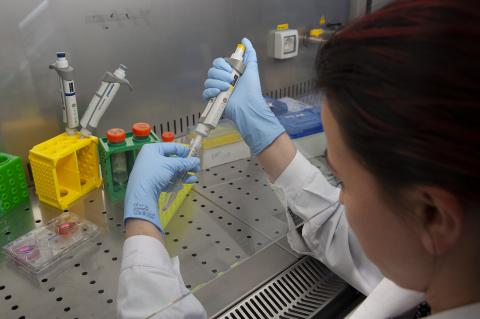REGENERATIVE MEDICINE, A BILAYER HYDROGEL ALLOWS THE RESTORATION OF THE NATURAL PROPERTIES OF AN ARTICULAR CARTILAGE IN AREAS WHERE THE TISSUE HAS DEGENERATED

The scientific collaboration between The BioRobotics Institute of Sant’Anna School and Istituto Ortopedico Rizzoli, has allowed the development of a bilayer hydrogel that imitates the characteristics of articular cartilage and restore its natural properties in the areas where the tissue has degenerated. The study, published in the international journal Advanced Healthcare Materials, aims to define a strategy for the resolution of joint problems, especially affecting the knee, through the use of functional material to recover the mechanical and lubricating properties of articular cartilage damaged by trauma or osteoarthritis.
"The hydrogel - declares Diego Trucco, first author of the study and PhD student of The BioRobotics Institute - is composed of two layers: the first layer mime the mechanical and lubricating characteristics of the surface area of human cartilage; the second layer acts in the deep zone, reproducing the mechanical characteristics of the cartilage of the knee. Hydrogel does not have cells (chondrocytes or stem cells), but could be considered as an acellular synthetic substitute".
The two hydrogels can be injected sequentially with minimally invasive surgery, such as arthroscopy. An alternative is to compose hydrogels externally and implant them surgically, going exactly to replace the damaged tissue area. Currently, thanks to the support of the Rizzoli Orthopedic Institute, the researchers have carried out two very important validation tests: the analysis of cytotoxicity of materials with the main cartilage cells, chondrocytes; the validation of the properties of the material through the use of a knee simulator capable of simulating a person's daily activity. The tests were successful. Further pre-clinical tests should, however, be carried out before a possible validation of the material at the clinical trial level can actually be considered.
"This study - explains Lorenzo Vannozzi, project manager of The BioRobotics Institute - is part of the research activity conducted within the European project H2020 ADMAIORA”.
"The cooperation between engineers, biologists, physicists - says Gina Lisignoli, Chief Biologist of the Laboratory of Immunoreumatology and Tissue Regeneration at the Rizzoli Orthopedic Institute - has been fundamental to achieving important results. This approach is an important piece for the transfer of results from laboratories to clinics."
"This result is combined with other interesting discoveries that we are making as part of the ADMAIORA project. We hope that this and other technologies can become a clinical reality within a few years", says Leonardo Ricotti, Associate Professor of The BioRobotics Institute and scientific responsible of the Regenerative Technologies Lab.
Diego Trucco, Lorenzo Vannozzi, Eti Teblum, Madina Telkhozhayeva, Gilbert Daniel Nessim, Saverio Affatato, Hind Al‐Haddad, Gina Lisignoli, Leonardo Ricotti, Graphene Oxide‐Doped Gellan Gum–PEGDA Bilayered Hydrogel Mimicking the Mechanical and Lubrication Properties of Articular Cartilage, Advanced Healthcare Materials, https://doi.org/10.1002/adhm.202001434





